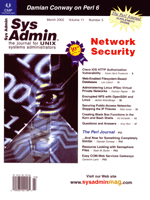 syslog syslog
With this March issue, we include our third supplemental issue
of The Perl Journal. These supplements have been well received
by readers, and I particularly appreciate the feedback from previous
TPJ subscribers expressing their gratitude and support of
our efforts on behalf of TPJ. Some time ago, Sys Admin's
publisher posted an open letter to readers on the TPJ Web
site explaining the necessity of binding TPJ into Sys
Admin. To recap the publisher's statements, the challenges
to the high-tech industry in the second half of 2001 took a toll
on high-tech publications in the form of reduced ad dollars and
forced many magazines to adopt severe cost-saving measures. For
example, big news magazines such as Computerworld and Infoworld
recently reduced circulation by as much as 40% to save on expenses,
and Internetworld, a sister CMP publication, has ceased publication.
Binding TPJ into Sys Admin magazine allows TPJ
to survive, and I hope provides a place where it will thrive.
There's been a sense lately of a shift in the market and
a more positive outlook for the future. In the field of systems
administration, just as in other areas, it seems that now is the
time to re-evaluate our current practices and look toward future
improvements. With tight budgets all around, we may not be able
to afford frivolous expenditure on the sexiest new piece of hardware.
To mitigate risk, we must look for proven technologies with minimal
up-front costs. Now is the time for pragmatic decision-making, careful
scrutiny of existing systems and policies, and for enhancing what
we have. We must also continue to educate ourselves and users in
the process of improving the security and reliability of our systems.
One particular article in this issue of TPJ represents
these ideas in action. In his article, "...And Now for Something
Completely Similar", Damian Conway provides insight into the
evolving state of the Perl language. In his entertaining and cogent
style, Conway describes the changes that users will see with Perl
6 and compares them to the current standard. He writes, "...
the real problem doesn't stem from those changes, nor even
from people's exaggerated fear of them. The real problem stems
from several billion years of evolution, which have inconveniently
wired our brains entirely the wrong way. The trouble is, we're
adapted to detect, highlight, and focus on anything new, different,
surprising, or unexpected and to ignore the old, the commonplace,
and the familiar."
Conway tells us that Perl 6 will certainly be different from Perl
5, but never gratuitously so. He says, "When syntax or semantics
change, it will always be a change for the better: for greater consistency,
for more intuitability, for extra Do-What-I-Meanness." These
guidelines can be just as sensibly applied to systems administration.
We must strive to implement only those security measures and policy
changes that will truly benefit our systems and users, and I hope
that the articles in Sys Admin and The Perl Journal
will be useful to you in making such decisions for your company.
Sincerely yours,
Amber Ankerholz
Editor in Chief
|

